Scotland. Scotland. Mystical stone circles, prehistoric settlements, rugged cliffs, white sandy beaches and woolly sheep. Welcome to the Orkneys! The islands in the north of Scotland enchant with their very own beauty and historical heritage. The Stone Age settlers, the Vikings and even the World Wars have left their mark on the islands. Read on to find out where the most exciting stories and the most beautiful landscapes are. In addition, there are a lot of practical tips for your road trip on the Orkney Islands.
Unassigned, unpaid advertising. The article contains affiliate links*.
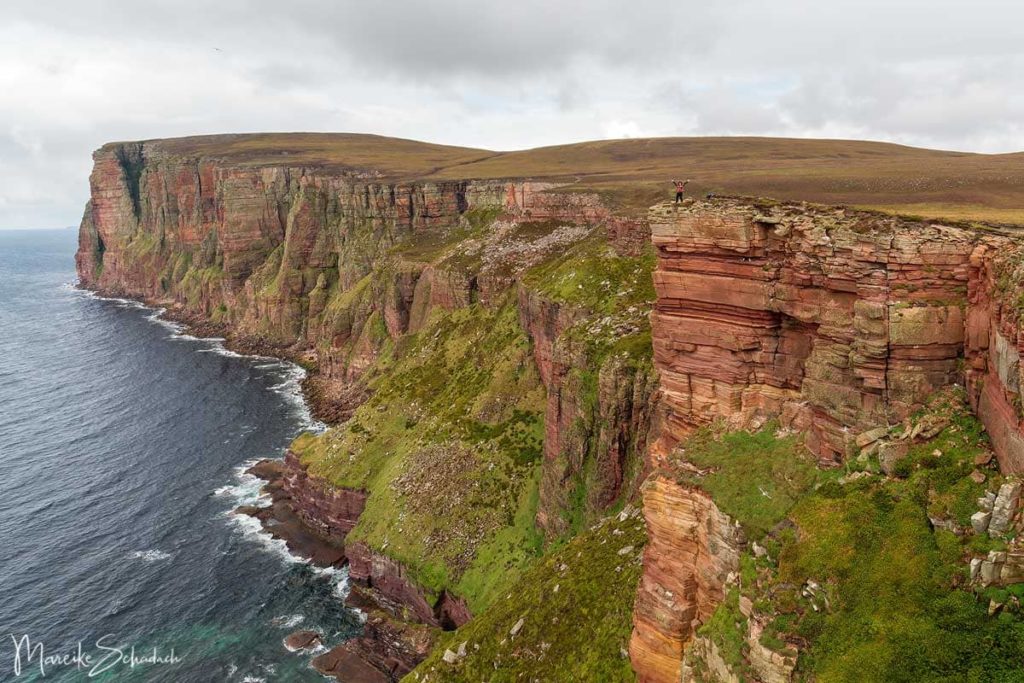
General Information about the Orkney Islands
Karte der Highlights und unserer “Campsites”
#1 Skara Brae - the Heart of Neolithic Orkney
#2 Skaill House - Orkney's haunted House
#3 The Falconry at Skaill House
#4 Ring of Brodgar - mystic Stone Circle
#5 Standing Stones of Stenness and Barnhouse Village
#6 Stromness Museum
#7 Coastal walk Yesnaby to North Gaulton Castle
#8 Brough of Birsay
#9 Enigmatic Whalebone Sculpture of the Orkneys
#10 Broch of Gurness
#11 St. Magnus Cathedral in Kirkwall
#12 Bay Inganess with the shipwreck Juniata
#13 Italian Chapel - the Miracle of Camp 60
#14 Churchill Barriers and Block Wrecks
#15 Hoxa Head Coastal Artillery Battery - Lost Place on the Orkneys
#16 “Old Man of Hoy” – Sea Stack auf den Orkneys
#17 Rackwick Bay - the most beautiful Beach of the Orkneys
What else is there?
General Information about the Orkney Islands
The Orkney Islands are an archipelago of about 70 islands and invite to a road trip with island hopping. However, only about 16 islands are inhabited. The largest and most important island is called "Mainland". It is connected with other islands via the “Churchill-Barriers” These include Lamb Holm, Glimpse Holm, Burray and South Ronaldsay. All other islands are only accessible by ferry or boat.
With the exception of the islands of Hoy and the Mainland, all islands are rather flat. The highest elevation is Ward Hill on Hoy with about 480 meters. Hoy and Mainland impress with their cliffs and sea stacs, such as the "Old Man of Hoy" or the Yesnaby cliffs. The rest of the islands are covered with heathland and lush green meadows.
Orkney is famous for its historical heritage. In addition to the prehistoric ruins, the famous Stone Age village of Skara Brae and the stone circles, this also includes the numerous abandoned military installations and - under water - the shipwrecks of Scapa Flow from the First World War.The islands are therefore not only popular with historians, hiking enthusiasts and hobby ornithologists - also divers like to come to dive the wrecks. These lie around 30 to 40 meters deep, it is cold and dark. This is only something for divers with dry suits and appropriate practice.For less experienced divers, however, there is the possibility to dive at the block wrecks at shallower depths.

Map of Highlights and Campsites from our Road Trip on the Orkney Islands
The following highlights are just some of the Orkney sights you can visit during your road trip. They are limited to the main islands, which are connected, and the island of Hoy.
Unfortunately, in September 2020 we couldn't visit all the places we would have liked to see. Some places had closed because of Covid-19.
On the map of the Orkney Islands you will find the highlights of our road trip and suggestions for possible places to pitch a tent.And that you can dive right in, I have also uploaded a small photo for each high light in the map.
#1 Skara Brae - the Heart of Neolithic Orkney
After a violent storm in 1850, the former owner of Skaill House, William Graham Watt, made a remarkable discovery. In the Bay of Skaill, the storm exposed strange stone formations. Upon closer examination, the remains of stone houses became apparent. Watt led excavations in the following years and uncovered a prehistoric settlement. The remains found are up to 5,000 years old. The Neolithic village of Skara Brae is probably the best known and most important excavation site in Orkney. Skara Brae is also considered to be the best preserved Neolithic settlement in the whole of Europe. The "heart of Neolithic Orkney" is therefore often called the Pompeii of Scotland. Skara Brae has been listed as a UNESCO World Heritage Site since 1999.

In a visitor center you can learn details about life in the Neolithic Age and the archaeological excavations in Skara Brae. Replicas of the stone houses show vividly what it must have looked like inside at that time.
#2 Skaill House - Orkney's haunted House
Skaill House is often called Orkney's haunted house. But what is it all about? From the outside it looks like a typical Scottish manor house.
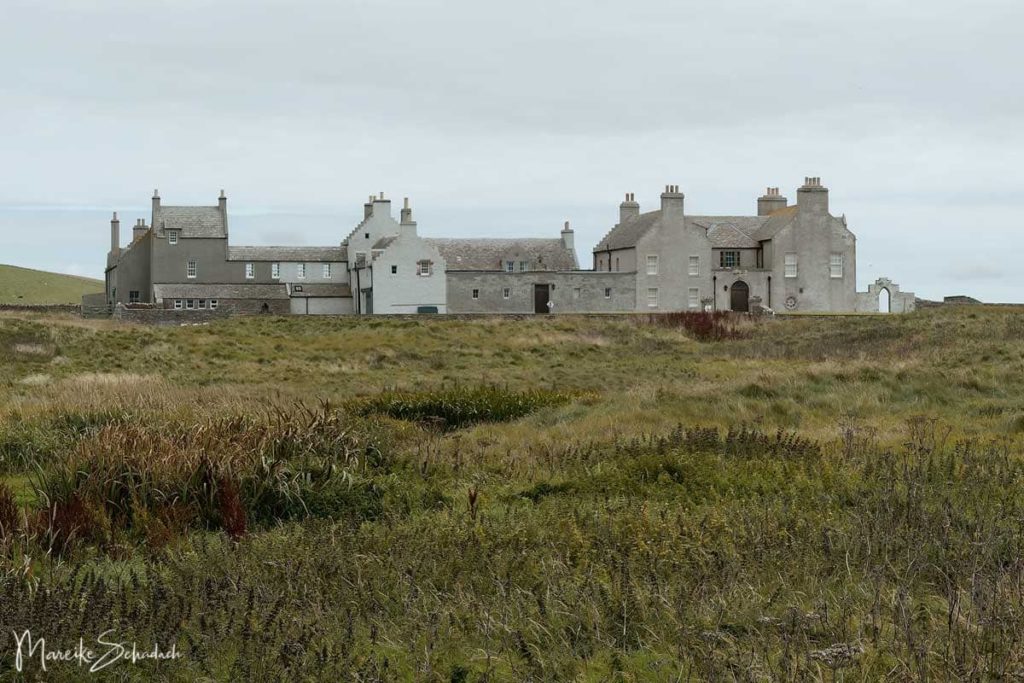
The house is isolated on the west coast of Orkney-Mainland near the archaeological site of Skara Brae. It was built in the 1620s by Bishop George Graham as a simple manor house. His son became Laird of Orkney. Since then, the house has been constantly expanded - space was needed for the family, for souvenirs, for guests and their numerous gifts. Over the course of 400 years, quite a few things have accumulated: a tiger skin from India, a tea service from Captain James Cook's last voyage, a flag of the Bolsheviks from 1919, and much more.

Skaill House has been open to visitors since 1997. The house is a real treasure chest, with artifacts from all over the world. Everything is lovingly arranged and carefully labeled. A truly worthwhile visit.
But something remains hidden from the visitor's eye: the skeletons under the wooden floor in the entrance area. They were found when the old stone floor was replaced with a wooden one. Research revealed that the south wing of Skaill House was partially built on an old Pictish cemetery. In order not to disturb the peace of the graves, the remains were put back. So it is logical that there are also stories about ghost sightings in Skaill House. Ubby is the name of the ghost and he is a man who is said to have built up an island in the neighboring Loch of Skail for years.
Tip: after sightseeing in Skara Brae and at Skaill House, you can laze around a bit in the nearby sandy cove . Tip for camping: Do you want to spend the night in a tent on your road trip across the Orkney Islands? Then this would be a good place to pitch your tent.
#3 The Falconry at Skaill House
A visit to the falconry at Skaill House is also worthwhile. It is located directly across from the entrance to the magnificent mansion. In the only falconry on the northern island of Scotland you can see owls, falcons and other birds of prey. You will learn about the animals, their training and falconry itself.

I was skeptical at first, because birds of prey have no business in captivity in my opinion. When I learned that the falconers walk their birds while they fly freely behind them doing their own thing, I was quite amazed. All the birds you see here can hunt on their own and might just fly away during training. If there wasn't a connection between the animals and their keepers.
In addition to flight demonstrations by the falconers, you will also have the opportunity to hold the falcon or owl yourself or have it land on your outstretched arm. With the appropriate inviting posture and a piece of meat on the leather glove, the four-kilogram eagle owl also landed on my hand and even let me scratch its belly.

#4 Ring of Brodgar - mystic Stone Circle
Only 21 of the 60 monoliths are still standing today, but the stone circle is so big that you can hardly see it with one look. With a diameter of 104 meters it is the third largest stone circle in Great Britain.Only those at Avebury and Stanton Drew are larger. Most of the stones are around two meters high. But one is particularly large - a full five meters is said to be it.
Wind and weather of the last 4,700 years have left their mark on the stones. One of the stones was even split by a lightning strike. All of them are overgrown with mosses and lichens, and when you take a closer look, they shimmer greenish and yellowish in some places. A great contrast when the heather blooms! When dark clouds hang over the monoliths, the mystical atmosphere here is perfect. How might it have been here in the past, when people came here to participate in unknown rituals?

#5 Standing Stones of Stenness and Barnhouse Village
The prehistoric Standing Stones of Stenness impress by their size. They are up to six meters high, more than three and a half times as tall as I am. A sheep seems tiny next to these stone giants. Today there are only three Standing Stones left. But about 5000 years ago there were twelve stone giants forming a circle with a diameter of 44 meters. A two-meter deep ditch surrounded the stones, and in the center was a large fireplace. Who or what was worshipped here, nobody knows exactly.
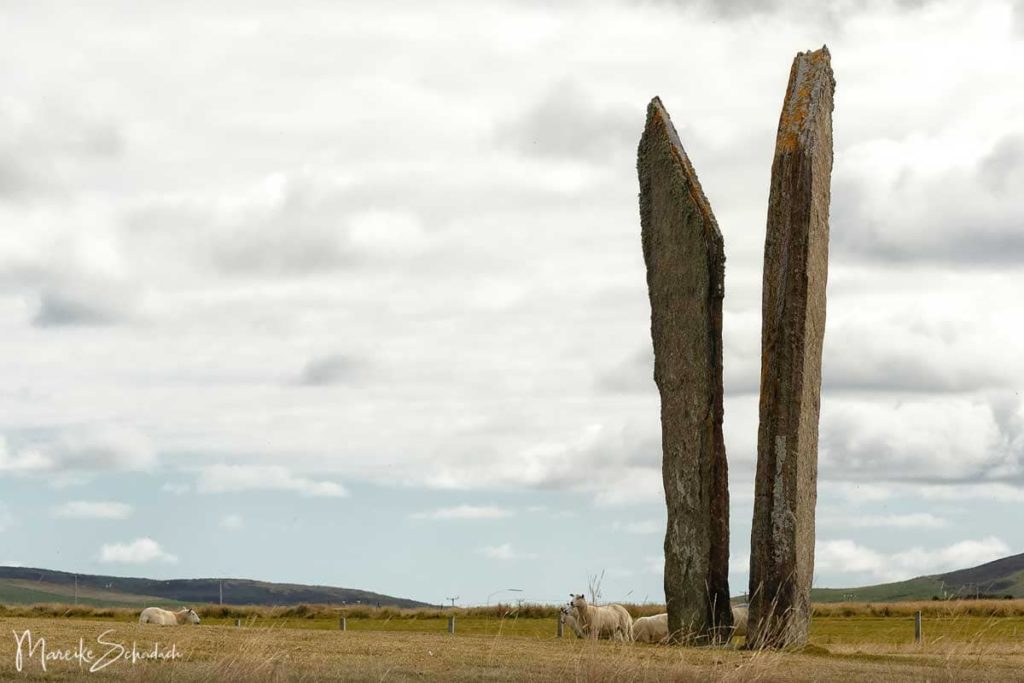
What would Scotland be without its legends and myths?And of course there is also a story about the Standing Stones of Stenness: the stones are actually fossilized giants. Every year, around New Year, they come to life. During the nights, the giants then go to the nearby hole to drink from it. Whoever observes them doing so is haunted by bad luck.
North of the Standing Stones is Barnhouse Village,which is also about 5000 years old. It once consisted of 15 houses. The settlement is said to have been similar to Skara Brae. There is even said to have been stone furniture, stoves and beds. Today, only the remains of the walls of four houses are preserved.
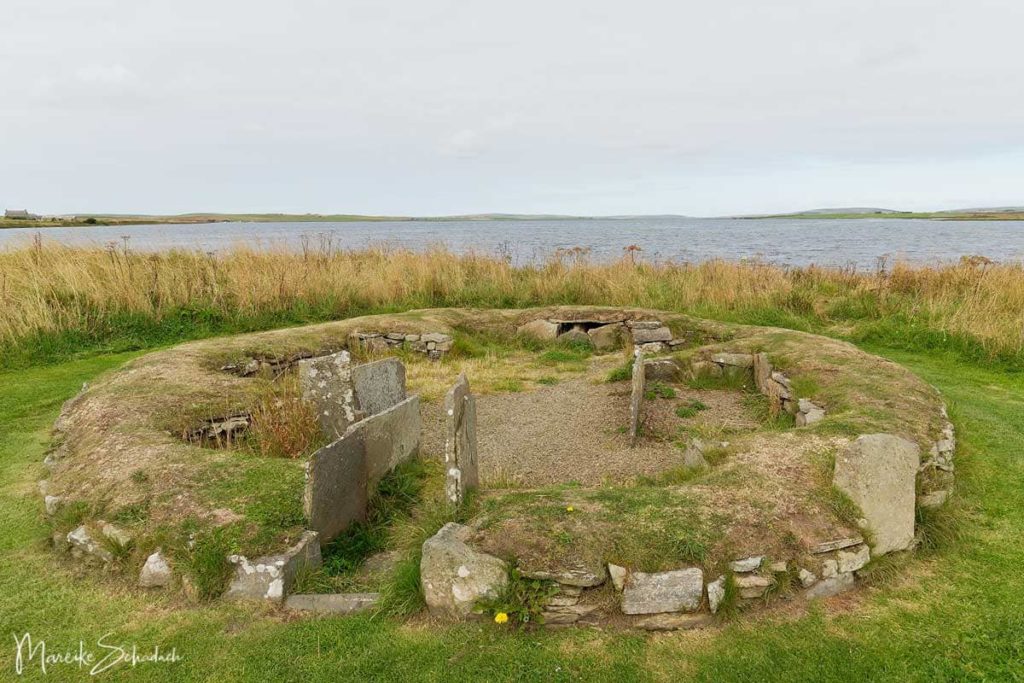
By the way: The name "Stenness" comes from the old nordic word "Stein - nes", which means "stone place".
#6 Stromness Museum
The small museum in Stromness is a real treasure chest. The exhibition is lovingly prepared and a colorful mixture of almost everything. Sometimes the exhibits seem a bit jumbled - next to stuffed animals are red pumps. But the logic behind it usually becomes clearer when reading the texts on the display cases.

The exhibition begins on the first floor with maritime and wartime history,including the famous wrecks of Scapa Flow.At the back of the building, Orkney-born polar explorer John Rae paddles one of the world's first inflatable boats. He is looking for traces of the lost Franklin Expedition - and makes a find. Inuit art and polar clothing complement the exhibits about Rae's expeditions.
The upper floor continues with the themes of archaeology, ethnology and natural history.Native birds impress with their size in display cases, and tiny shells are carefully arranged in showcases.
All in all, very worthwhile. Allow at least 45 minutes for your visit. Current opening hours and entrance fees can be found here.
#7 Coastal walk Yesnaby to North Gaulton Castle
The coastline at Yesnaby is one of the most beautiful in Orkney.A short walk offers spectacular views of a wild cliff with seastacks, caves and rock arches. In summer, numerous seabirds breed on the rugged cliffs. At the foot of the cliffs, the waves crash thunderously against the rocks. During or shortly after a storm from the west, the waves are especially high, making the hike an unforgettable experience.
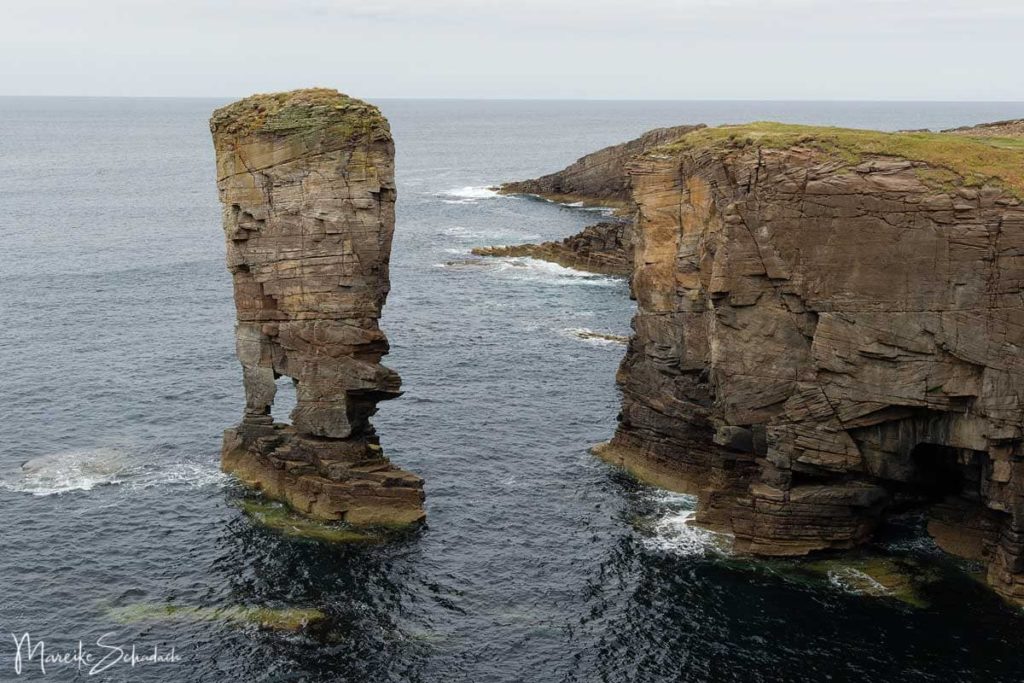
From the parking lot you walk the coastal path always south. There are several trails. Some of the paths go around the headlands and are a bit longer, others connect the bays on the shortest way. Just let yourself drift and go exploring.
The North Gaulton Castleis a seastack about 52 meters high. It is the highlight of the hike and was also the turning point for us. But only after we enjoyed the view at a long picnic.
Length: about 7.5 kilometers
Duration: at least 2.5 hours
Starting point: Mainland; parking at the former flak positions of Yesnaby, at the end of the road to Yesnaby
Book recommendation:
This and 49 other hikes can be found described in detail and with GPS tracks in the Rother hiking guide*.
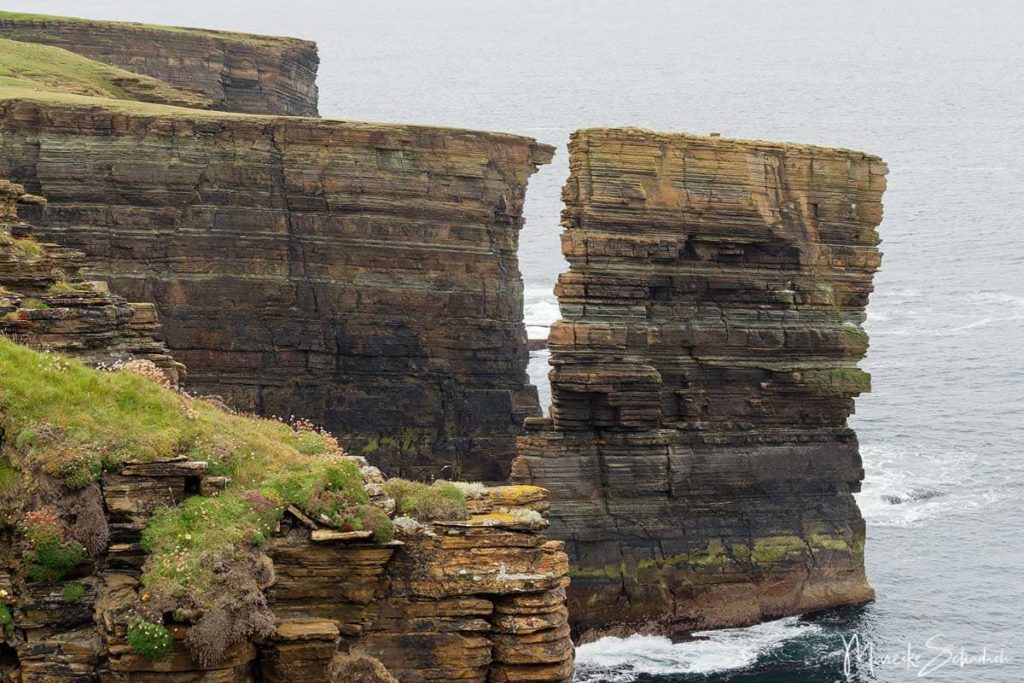
#8 Brough of Birsay
The Brough of Birsay is a tidal island in the northwest of the main island of Orkney. The main attraction of the island are the archaeological remains of a Pictish settlement as well as remains of Viking buildings.
Birsay is accessible only during low tide via a narrow concrete causeway. The time window for a visit begins about two hours before low tide and ends about two hours after. Click here for the tide table.

When the sea recedes, the rocky seabed with countless tide pools is revealed. The rocks as well as the cliffs are great photo opportunities and there is much to discover. Maybe you will be lucky and find one of the coveted cowrie shells.
By the way, in summer Birsay is supposed to be one of the best places to watch puffins. Unfortunately we didn't see any. Because in August the puffins leave their breeding caves and spend the rest of the year on the open sea. Only in April/May of the next year they come back to the land to breed.

At the northwest end of the island stands a small unmanned lighthouse.It was built in 1925 by David Alan Stevenson. The Stevensons built lighthouses for several generations and are famous in Scotland as a lighthouse building family.
#9 Enigmatic Whalebone Sculpture of the Orkneys
It looks like an owl sitting on a wooden post. Just now, it spreads its wings and starts to fly. But as you get closer, you realize that the owl is a big bone. The post is also a bone. Two huge whale bones are stuck together here to form a strange sculpture. How did the bones get here? And for what purpose was the Whalebone sculpture erected here in Orkney? Learn more in my separate article about the Whalebone sculpture at Birsay.

#10 Broch of Gurness
The Broch of Gurness is an Iron Age settlement located on a beautiful stretch of coastline in the north of Mainland. It consisted of about 14 houses arranged around a central tower. With a diameter of 20 meters and a height of 3.5 meters, the Broch of Gurness is the largest preserved tower of its kind.For defense, ramparts and ditches were built around the settlement.

The site is about 2000 years old. It was excavated in the late 1930s and is amazingly well preserved. Besides the remains from the Iron Age, the excavations also found evidence of later use of the site by Picts and Vikings.
Unlike Skara Brae, you can walk among the ruins and go inside the remains of the houses and the tower. Information boards explain what there is to see. Among them are a stone toilet, shelves, beds, fireplaces and a washbasin for possible ritual purposes.
#11 St. Magnus Cathedral in Kirkwall
The northernmost cathedral in Britain is dedicated to St. Magnus of Orkney. Magnus lived around 1100 AD. As Earls of Orkney, he and his cousin Hakon ruled the islands. But as can happen in the best of families, Hakon betrayed Magnus and had him executed. Shortly thereafter, miracles occurred on the Orkneys. Who else, if not the Christian Magnus, could have caused these miracles?

The cathedral is built of different colored sandstone, which gives it a very distinctive look. And there is something else that makes the cathedral special: St. Magnus has its own dungeon - "Marwick's Hole".
The cathedral is surrounded by a graveyard where, among others, the Scottish Arctic explorer Dr. John Rae found his burial place. Inside the cathedral there is also a memorial to the explorer from the Orkneys.
#12 Bay Inganess with the shipwreck Juniata
Bay Inganess is a picturesque bay with an extremely photogenically placed shipwreck - the Juniata. The tanker was completed under the name Sprucol in 1918. Then on April 17, 1940, the ship was sunk under the name Juniata. Thus, the Juniata became part of the fourth Churchill Barrier between South Ronaldsay and Burray islands. Nine years later, however, she was lifted and was to be taken to a shipbreaking yard. But the condition of the wreck was already so bad that she was beached again in Bay Inganess. Only the stern was apparently salvaged. All that remains is the bow of the ship, which now overlooks the beach as a rusty piece of wreckage.
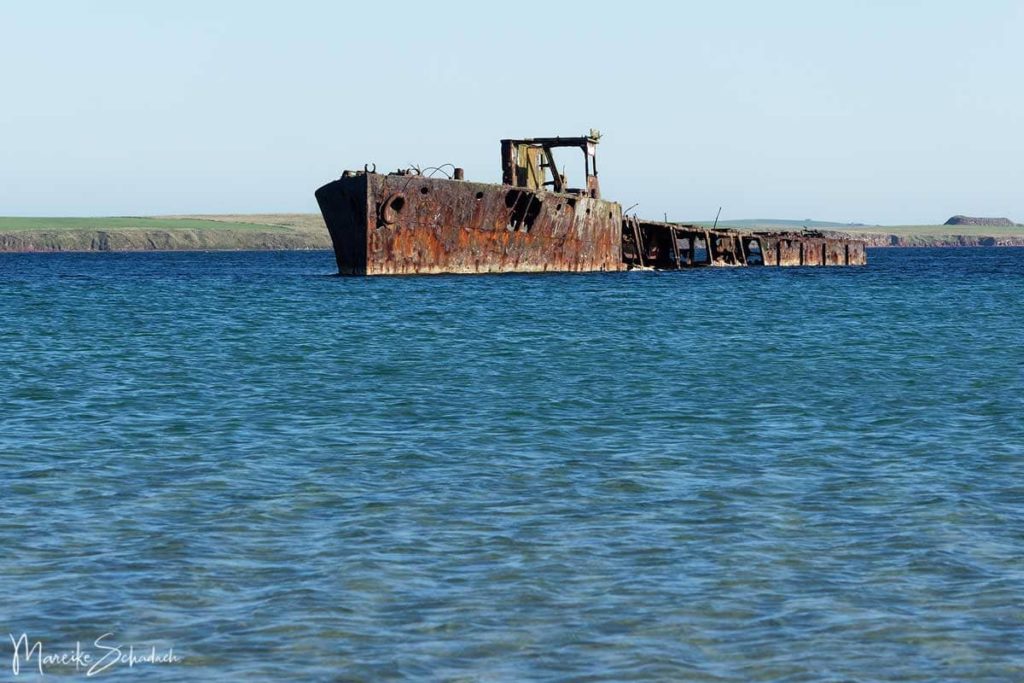
Opposite the Bay Inganess is a nice picnic area and there is a loop trail with bird-watching opportunities.
Tip for camping: Do you want to spend the night in a tent on your road trip across the Orkney Islands? Then this would be a good place to pitch your tent.
#13 Italian Chapel - the Miracle of Camp 60
The Italian war prisoners who built the Churchill Barriers built an Italian chapel on Lamb Holm. Beginning in 1942, the "Miracle of Camp 60" was constructed with the simplest of means from two Nissen huts joined together. Today, the Italian Chapel is one of Orkney's main attractions and is also in the highest category of the Scottish Heritage List.
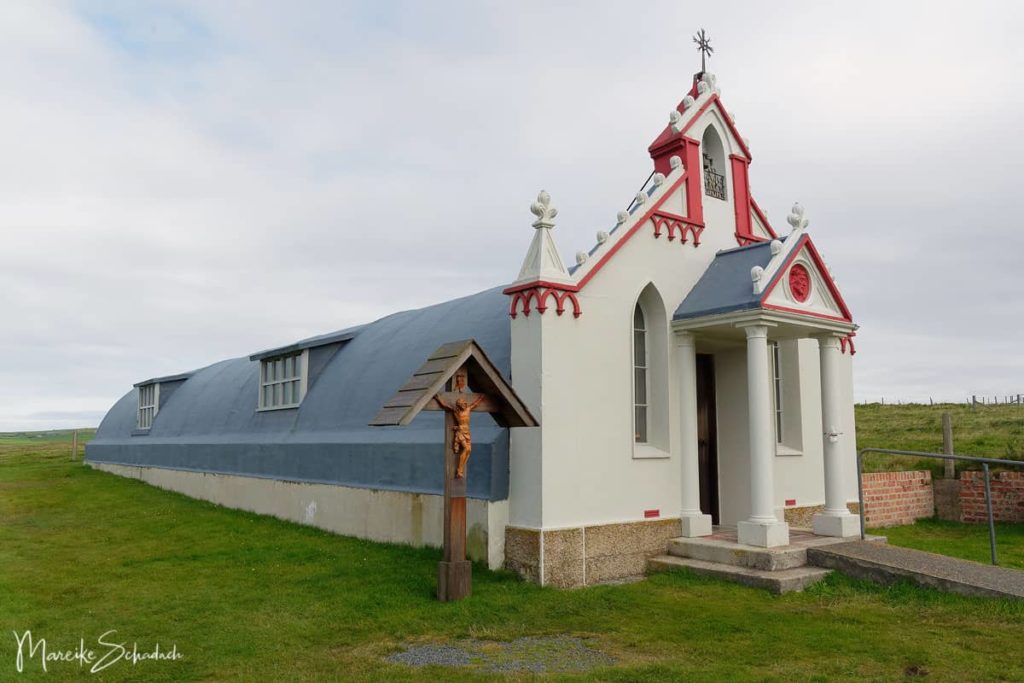
The first thing the prisoners made was a figure of St. George, the dragon slayer. With the permission of the camp director and under the direction of Domenico Chiocchetti, the prisoners of war brought a bit of home to the north with the chapel. Everyone contributed something to the realization of the Miracle. In 1944 the chapel was finally finished. However, Camp 60 was disbanded shortly thereafter - the war was over and the Churchill Barriers were completed. The chapel, built with much love, remained unused and threatened with decay.

In 1960, the then site manager Domenico Chiocchetti was invited to Orkney. Together with local craftsmen he restored the Italian Chapel. In 1992, exactly 50 years after construction began, the prisoners of that time came back to Lambs Holm and celebrated a Mass together in their "Miracle of Camp 60."
#14 Churchill Barriers and Block Wrecks
Scapa Flow Bay was the most important base for the Royal Navy during both world wars. Due to the surrounding islands, the ships were well protected here during storms. However, on October 14, 1939, the German submarine U 47 entered the bay and subsequently sank the battleship HMS Royal Oak, killing 833 men.
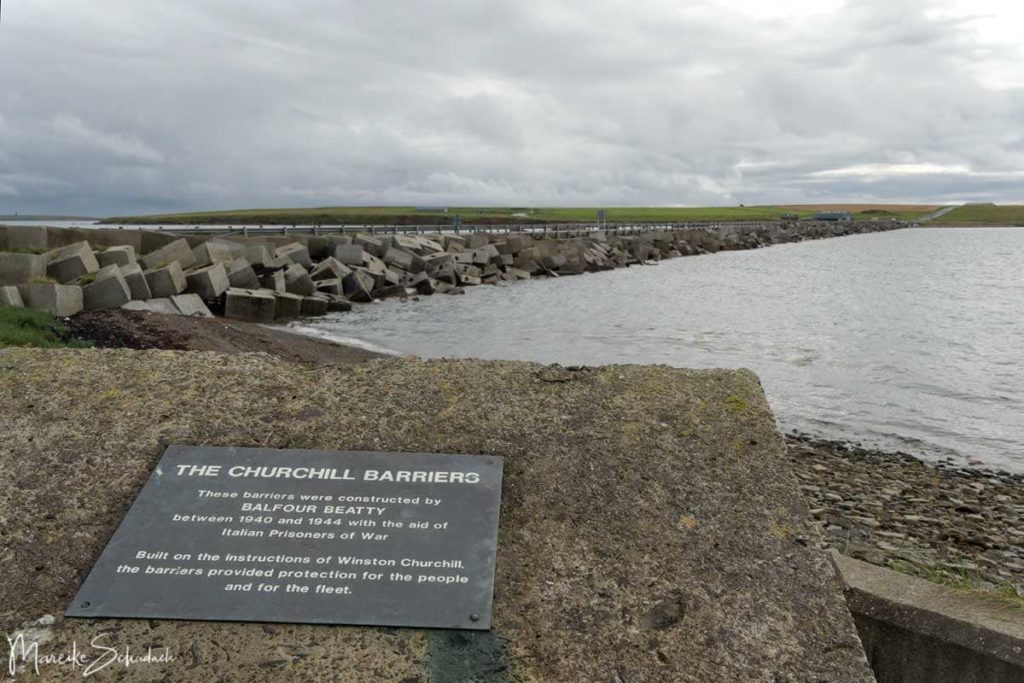
In order to protect the fleet from further attacks by German submarines, British Prime Minister Winston Churchill subsequently ordered the construction of barriers. The Churchill Barriers were thereafter to prevent passage for ships between the islands of Mainland, Lamb Holm, Glimbs Holm, Burray and South Ronaldsay. To this end, ships were initially sunk in the passages beginning in May 1940. This was followed by 40,000 cubic meters of stone and 300,000 tons of concrete blocks. The dams were declared at the time as a necessary road construction project to connect the individual islands. In fact, with this trick, prisoners of war could be used for the work. This was because, according to the Geneva Convention, the use of prisoners of war was only allowed for civilian purposes, not for military ones. The 1,300 Italian war prisoners worked on the barriers for five years at that time. On May 12, 1945 - at the end of the war - the road link across the Churchill Barriers was finally opened.

#15 Hoxa Head Coastal Artillery Battery - Lost Place on the Orkneys
The Orkney Islands are littered with relics from the two world wars. Especially well known are the Churchill Barriers and the wrecks of Scapa Flow. But no less impressive are the numerous ruins of bunkers and defense installations on the Orkneys, for example at Hoxa Head. A circular walk along the coast leads past the ruins of the coastal artillery battery and gives you an idea of the strategic importance of the Orkneys at that time. Since I found the place so exciting, I have a separate article about the Coastal Artillery Battery Hoxa Head .

Tip for camping: Do you want to spend the night in a tent on your road trip across the Orkney Islands? On the way to Hoxa Head you will pass a beach with a toilet house. This would be a good place to pitch your tent.
#16 “Old Man of Hoy” – Sea Stack auf den Orkneys
If there is a "Must Do" on Orkney's island of Hoy, it is a visit to the old man - the "Old Man of Hoy". This is because the popular coastal walk leads to one of Scotland's most famous Sea Stacks.The rewarding hike is rounded off by stunning views along the rugged red sandstone cliffs as well as good opportunities for bird watching. Learn more in my separate article about the Hike to the "Old Man of Hoy" incl. practical Tips.
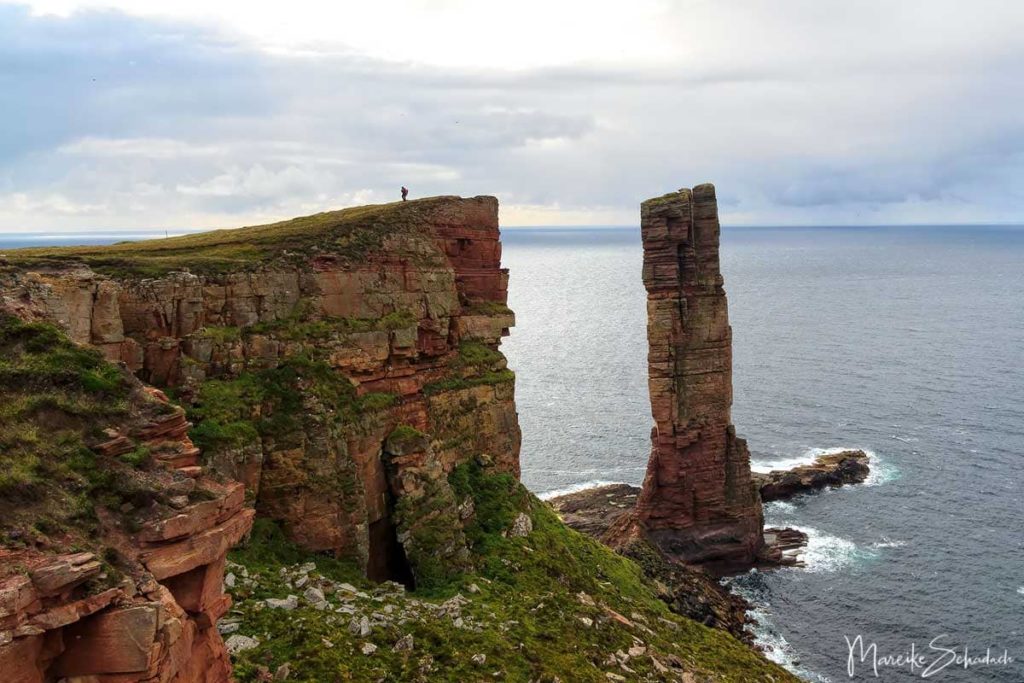
#17 Rackwick Bay - the most beautiful Beach of the Orkneys
It is said that Rackwick Bay is the most beautiful beach in Orkney. That may well be, I have not seen a more beautiful one. It is especially beautiful in the evening light, when the sand glows golden. The big round stones decorate the beach like Christmas balls. I have not seen anything comparable on any other beach in Orkney.

Tip: In Rackwick Bay there is a bothy where you can stay overnight.We pitched our tent here for the night. The location is beautiful, but... Midges! There were already many in the evening. But in the morning, a thick midge fog surrounded us. So, before you camp here, read my article Midges in Scotland - When? Where? What helps?
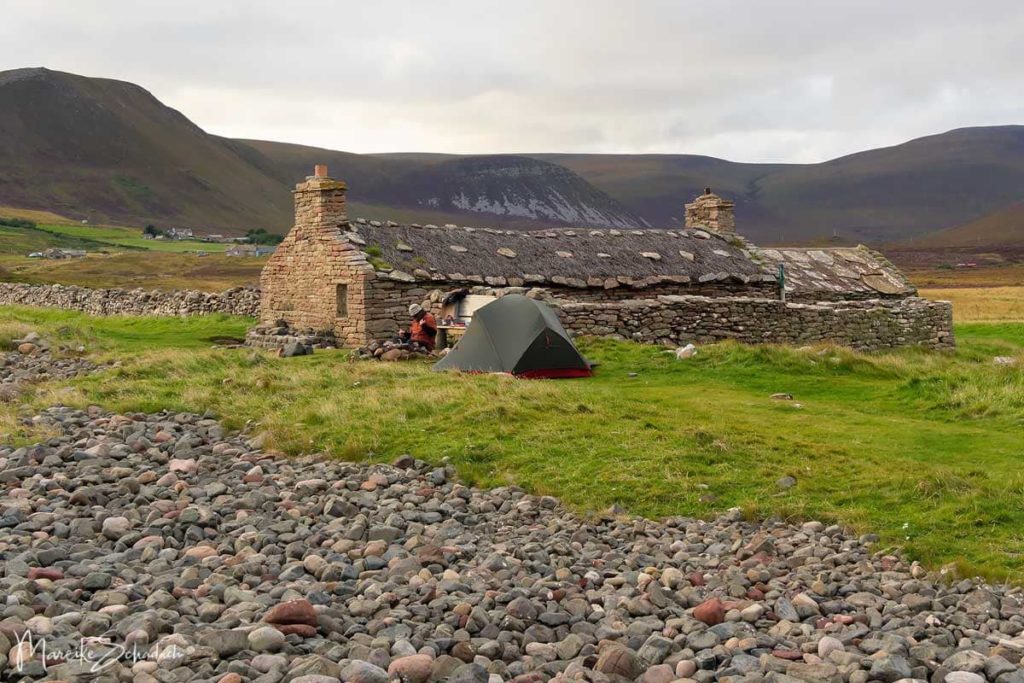
What else is there?
During the Covid Summer 2020, unfortunately not all prehistoric sites in Orkney were open. These included the Neolithic burial chambers Maeshow Chambered Cairn on Mainland and Tomb of the Eagles and Tomb of the Otters on South Ronaldsay. We would also have liked to visit the Scapa Flow Museum on the Isle of Hoy. But it was closed for renovation. Will I travel to the Orkneys again? I am pretty sure, yes. Because besides the places mentioned before, I would like to plunge into the floods and dive to the wrecks and then warm up again on land while watching the cute puffins.

Book Recommendations for your Road Trip to the Orkney Islands
Do you want to know where the journey is going? Then I can recommend this travel guides* to you.
You can order the travel guides at Amazon by clicking on the pictures. If you buy a product via an affiliate link, I get a small commission and you help me to keep filling Fernweh-Motive with interesting articles. The product will not be more expensive for you and you do me a huge favor.
Do you know the Orkneys? What did you like best there? Do you have any questions or suggestions to my article? If so, please write me a comment!
Do you want to know when there are new articles on my blog? Then follow me on Facebook, Pinterest or Instagram. I would also be very happy if you share my article with your friends.
Recommendations for further Reading
Do you love wild coasts and lonely landscapes as much as I do? Then you might also be interested in my articles about a Kayak Tour in the Swedish Archipelago or a Trekking Tour to the Greenlandic Ice Sheet.

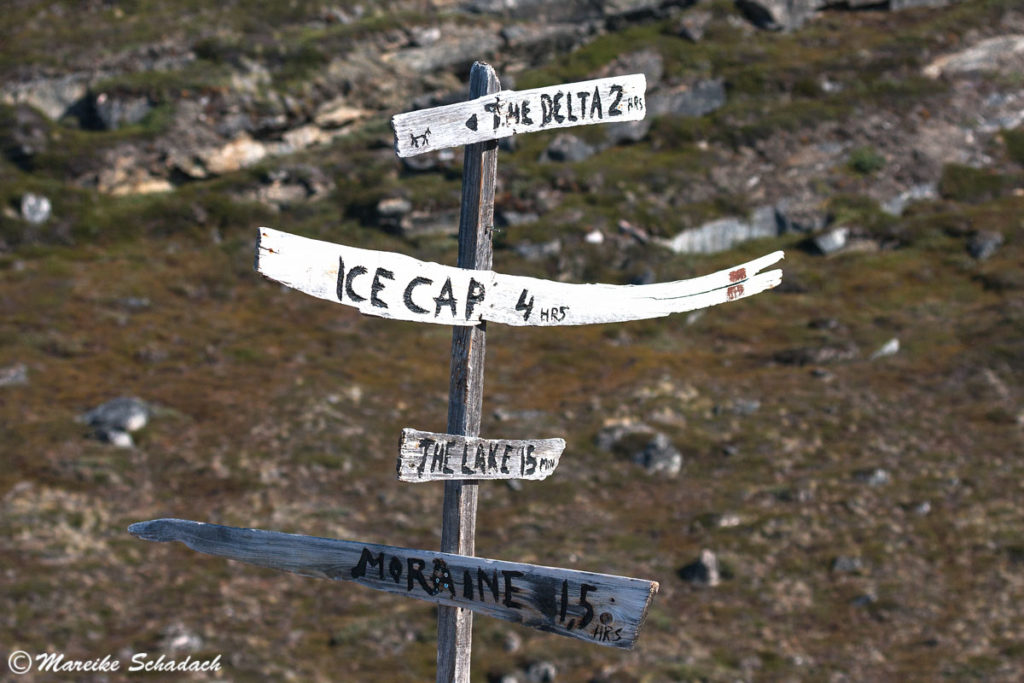
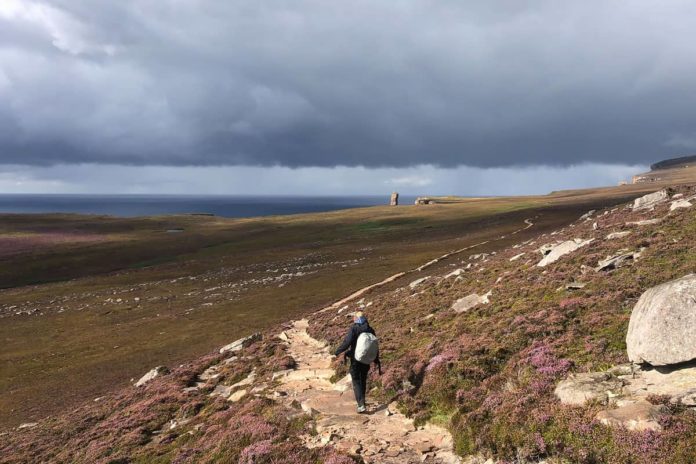




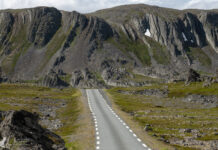
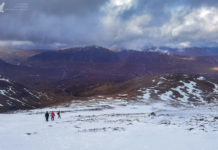
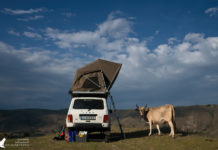
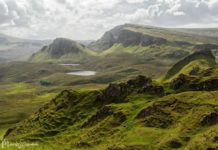
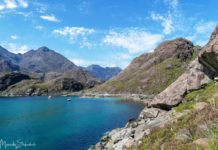

Schöner Bericht und tolle Bilder. Leider haben wir nur Kirkwall besucht, die St. Magnus Kathedrale und die italienische Kapelle waren beide sehr beeindruckend. Wie ich sehe, sollten wir die Orkneys noch einmal mit mehr Zeit besuchen.
Liebe Elke, vielen Dank für Dein Feedback zu meinem Artikel, ich freue mich dass er Dir gefällt und dass er Dich vielleicht eines Tages nochmal auf die Orkneys lockt. Mir haben diese Inseln auch so gut gefallen, dass ich gerne nochmal zurück möchte, dann aber zu der Brutzeit der Papageientaucher 🙂
Mareike